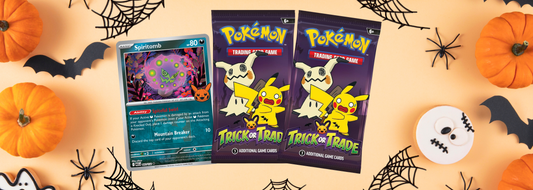
How to Build Your First Magic: The Gathering Deck (Beginner’s Guide)
Building your first Magic: The Gathering (MTG) deck can feel overwhelming. Between formats, colors, and card types, the options seem endless. But once you’ve learned the rules of play, deckbuilding is where the real creativity and strategy begins. This guide will walk you through the essentials of how to build a MTG deck step by step.
We’ll cover the key principles that make decks consistent, fun, and competitive, along with a few veteran tips to help you avoid rookie mistakes.
Step 1: Choose a Format
MTG has multiple formats, each with its own rules. For your first deck, stick with Standard, the most popular and beginner-friendly constructed format.
- Deck Size: Minimum 60 cards
- Copies Allowed: Up to 4 of any card (except basic lands)
- Card Pool: The most recent official sets
In order to keep the metagame fresh, Standard uses a rotating pool of sets. About once a year, Wizards of the Coast announces which older sets will “rotate out” and which new ones will join the format. You can always check official sources like MTG Arena or Scryfall to confirm which sets are currently legal.
| Pro Tip: Stick close to 60 cards. Fewer cards = higher consistency = more wins. |
Other formats like Commander (EDH) or Draft/Sealed (Limited) are great later on, but Standard teaches the fundamentals: synergy, mana curve, and win conditions.
Step 2: Define Your Deck’s Goal (Win Condition)
Before you start pulling cards together, decide what your deck’s win condition (the main way it plans to achieve victory) will be. That might mean overwhelming your opponent with fast, aggressive creatures, outlasting them with removal and card draw, or assembling a clever combo that ends the game in one turn.
| Pro Tip: Ask yourself: “How does my deck win?” If you can explain it in one or two sentences, you’re already thinking like a deckbuilder. |
From there, every card you include should support that plan, whether that’s helping you win faster, survive longer, or stay consistent. A clear win condition prevents your deck from becoming a pile of “good cards” that don’t work together. Decks that know their purpose tend to win far more often than those that don’t.
Step 3: Choose Colors That Fit Your Plan
Once you know how your deck wins, the next step is choosing the colors of mana that support that plan. Each of Magic’s five colors has its own philosophy and playstyle:
 |
White focuses on teamwork, defense, and small creature armies. |
 |
Blue controls the game with counterspells and card draw. |
 |
Black uses sacrifice, removal, and graveyard recursion. |
 |
Red plays fast and aggressive, dealing quick damage with creatures and burn spells. |
 |
Green ramps up mana and summons large, powerful creatures. |
When you’re still learning how to build a MTG deck, it’s best to stick to one or two colors. Mono-color decks are simpler and more consistent (you’ll never draw the wrong type of land).
Two-color decks add flexibility, letting you blend strengths (like red’s speed with black’s removal). More than that can get tricky fast, so master the basics before you start juggling three or more colors.
Step 4: Balance and Structure: The 60-Card Framework
Now that you’ve chosen your colors and a clear goal, it’s time to shape your deck into a cohesive 60-card machine. Most Standard decks follow a simple framework:
- 36 nonland cards
- 24 lands
That ratio gives you a reliable balance between action and resources.
| Pro Tip: A helpful rule for beginners learning how to build a MTG deck is to follow the “Rule of Nine.” Choose nine distinct cards that fit your deck’s strategy—creatures, spells, or enchantments—and include four copies of each. That gives you 36 nonland cards that appear often enough to make your deck consistent. From there, fill the remaining slots with lands that match your colors. |
Step 5: Understanding the Mana Curve
The mana curve is the heartbeat of every deck. It determines your pacing and how often you can make plays. A good beginner curve looks like a pyramid: more low-cost cards, a solid handful in the middle, and only a few expensive finishers at the top.
- Aggro decks thrive on 1- and 2-mana plays that apply early pressure.
- Control decks lean on 4- to 6-mana cards that dominate the late game.
We recommend laying out your deck by mana cost. If you have too many expensive cards and nothing to do early, you’ll fall behind. Too many cheap cards, and you’ll run out of gas later.
| Pro Tip: You should be able to use all your mana every turn. Idle mana = wasted potential. |
Step 6: Building a Reliable Mana Base
You can’t win if you can’t cast your spells. A good mana base ensures you always have the right colors available.
Start with around 24 lands, adjusting slightly for your deck’s speed:
- If your deck is full of cheap, fast cards, you might lower that to 22.
- If your spells cost more or you’re running control-style cards that need lots of mana, bump it up to 25 or 26.
Dual lands (which tap for two colors) are helpful, but not essential for beginners. A balanced mix of basic lands still works fine when your color spread is thoughtful.
Step 7: Playtesting and Refinement
No deck, no matter how well-planned, plays perfectly on the first try. Once your deck is sleeved and ready, it’s time to test.
- Start by “goldfishing”: drawing practice hands and playing a few turns as if your opponent does nothing. This helps you see whether your deck flows smoothly or stalls out early.
- Next, play real matches. Pay attention to which cards shine and which ones consistently feel clunky or useless. If you often find yourself stuck on mana, add a land or two; if you’re drawing too many lands, cut one.
Learning how to build a MTG deck is a living process. Small adjustments can make a big difference in consistency and power.
| Pro Tip: Be humble enough to learn from others. Sites like Moxfield or Archidekt let you browse proven decklists for inspiration. Borrow ideas, test variations, and refine until the deck feels like your own. A good builder knows that no deck is ever truly finished, but just keeps evolving with every game. |
Final Step: Protect Your Build
You’ve built your first deck, now you just need to protect it.
Every card you’ve chosen is part of your strategy, and keeping them in top condition matters just as much as the plays you make. Goat Armor’s premium sleeves, holders, and binders keep your deck safe from scratches, wear, and bending so you can focus on winning, not worrying. Whether you’re shuffling up at home or heading to your local game store, give your cards the protection they deserve.






